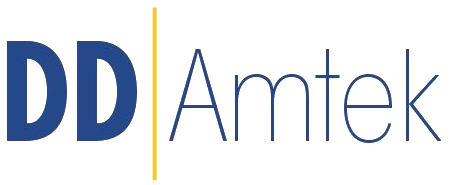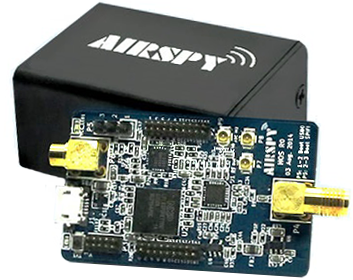
e-Shop DD Amtek
radiokomunikační a měřicí technika
Můžete se
přihlásit
anebo si
založit konto
AirSpy R2 - SDR přijímač

SDR přijímač - 24-1800MHz
-----
The Airspy R2 is one of the best known SDR receivers on the market. It offers a continous reception range from 24 to 1800 MHz,
which makes it suitable for analysis and reception of a large number of VHF and UHF signals. To receive the entire HF band
(plus long and medium wave) an optional up converter is offered, which is perfectly tuned to match the receiver.
For applications with limited space, the Airspy SDR is also offered as Airspy Mini in a traditional USB stick format.
The performance parameters are similar, just some components and features were removed due to space restrictions.
The real capabilities of an SDR are determined by the software.
The designers of the Airspy SDR are the same people who also write the SDR# (SDR sharp) software.
Because of this perfectly aligned joint development of hard and software the resulting system can do things which are hard to achieve for
other manufacturers. The SDR# software is one of the best known and most often used programs for SDR operations - for good reasons.
It is easy to operate and offers intuitive operations for many functions.
The open plugin architecture allows other program authors to offer even more functions, and the user can combine functions as his or her
requirements demand. Due to the joint development of hard and software the Airspy and SDR# software are always perfectly tuned to work together.
Airspy R2 description
The Airspy R2 receiver builds upon the widely used R820T2 tuner chip made by Rafael Electronis. In combination with a powerful 32 bit Cortex ARM
processor and a fast 12 Bit AD converter, the Airspy can get much more out of this tuner chip than usual DVB-T sticks with RTL chipset.
For example the ARM chip can process much larger datasets, which results in a wider spectrum span for the user. The Airspy can display approx.
10 MHz at a glance (9 MHz alias free). The Cortex ARM ship is also responible for the fast data transfer over the USB 2.0 interface.
The SDR employs a special clock generator with very low phase noise and a precision of ±0.5 ppm. The low phase noise helps to increase the s
ensitivity and dynamic range of the receiver. A very nice feature of the Airspy R2 is the possibility to inject an external reference clock.
This can come from a Rubidium or GPS disciplined clock generator to supprt measurements with highest precision, or to correlate multiple receivers.
Various GPIO port are available to control external devices. A bias voltage can be switched on to the antenna connector to supply external
apmplifiers or suitable converters (see below).
Another important feature is the open documentation of the software interfaces (API). Even when you are not a software author yourself, you will
benefit from this because other software engineers can (and do) provide extensions, plugins and own programs for the Airspy.
For example you will find ExtIO DLLs or drivers for other operating systems. Also the firmware of the ARM processor of the Airspy is available in
source code and allows own adoptions.
irspy R2 sets a new level of performance in the reception of the VHF and UHF bands thanks to its low-IF architecture, high quality ADC and state of the art DSP.
The coverage can be extended to the HF bands via the SpyVerter up-converter companion.
The Airspy R2, like its predecessor is 100% compatible with all the existing software including the de facto scanning standard SDR#, but also a number of popular software defined radio applications such as SDR-Radio, HDSDR, GQRX and GNU Radio.
For a more complete list of supported software, check the download page.
Purchase!
Typical Applications
VHF/UHF/SHF Radio Monitoring
Coherent Receiver Array
Direction Finding
Passive Radar
ADS-B, ATC
Radio Astronomy
Satellite IF
Telemetry Radio Receiver
Wide Band Scanner
Education
Ham Radio, etc.
Supported platforms
Windows Vista, 7, 8, 8.1 and 10 (For Windows XP, please contact us)
Linux
*BSD
OSX
Technical specifications
Continuous 24 – 1800 MHz native RX range, down to DC with the SpyVerter option
3.5 dB NF between 42 and 1002 MHz
Tracking RF filters
35dBm IIP3 RF front end
12bit ADC @ 20 MSPS (10.4 ENOB, 70dB SNR, 95dB SFDR)
10MSPS IQ output
Experimental 2.5MSPS IQ output for low power devices (Raspberry Pi, Odroid, etc.)
Up to 80 MSPS when using custom firmware
Cortex M4F @ up to 204MHz with Multi Core support (dual M0)
0.5 ppm high precision, low phase noise clock
1 RTC clock (for packet time-stamping)
External clock input (10 MHz to 100 MHz via MCX connector) – Ideal for phase coherent radios
10 MHz panoramic spectrum view with up to 9MHz alias/image free
IQ or Real, 16bit fixed or 32bit float output streams
No IQ imbalance, DC offset or 1/F noise at the center of the spectrum that plagues all the other SDRs
Extension ports: 16 x SGPIO
1 x RF Input (SMA connector, up to 30kV ESD protection)
1 x RF Output (Loopthrough, U-FL, 15kV ESD protection)
2 x High Speed ADC inputs (up to 80 MSPS, U-FL, DC coupled, 15kV ESD protection)
4.5v software switched Bias-Tee to power LNA’s and up/down-converters
8 x programmable high speed gpio’s up to 100MHz
3 x programmable synchronized clock outputs up to 160MHz
1 x core CPU clock output
1 x reset pin
2 x regulated +5.0 and +3.3v pins
1 x JTAG header
No drivers required! 100% Plug-and-play on Windows Vista, Seven, 8, 8.1 and 10
Operating temperature: -10°C to 40°C
Minimum hardware requirements
3rd gen Intel i3 2.4 GHz CPU or equivalent
2GB of RAM (to run your own OS, airspy barely needs 1MB of memory)
High speed USB 2.0 controller
-----
The Airspy R2 is one of the best known SDR receivers on the market. It offers a continous reception range from 24 to 1800 MHz,
which makes it suitable for analysis and reception of a large number of VHF and UHF signals. To receive the entire HF band
(plus long and medium wave) an optional up converter is offered, which is perfectly tuned to match the receiver.
For applications with limited space, the Airspy SDR is also offered as Airspy Mini in a traditional USB stick format.
The performance parameters are similar, just some components and features were removed due to space restrictions.
The real capabilities of an SDR are determined by the software.
The designers of the Airspy SDR are the same people who also write the SDR# (SDR sharp) software.
Because of this perfectly aligned joint development of hard and software the resulting system can do things which are hard to achieve for
other manufacturers. The SDR# software is one of the best known and most often used programs for SDR operations - for good reasons.
It is easy to operate and offers intuitive operations for many functions.
The open plugin architecture allows other program authors to offer even more functions, and the user can combine functions as his or her
requirements demand. Due to the joint development of hard and software the Airspy and SDR# software are always perfectly tuned to work together.
Airspy R2 description
The Airspy R2 receiver builds upon the widely used R820T2 tuner chip made by Rafael Electronis. In combination with a powerful 32 bit Cortex ARM
processor and a fast 12 Bit AD converter, the Airspy can get much more out of this tuner chip than usual DVB-T sticks with RTL chipset.
For example the ARM chip can process much larger datasets, which results in a wider spectrum span for the user. The Airspy can display approx.
10 MHz at a glance (9 MHz alias free). The Cortex ARM ship is also responible for the fast data transfer over the USB 2.0 interface.
The SDR employs a special clock generator with very low phase noise and a precision of ±0.5 ppm. The low phase noise helps to increase the s
ensitivity and dynamic range of the receiver. A very nice feature of the Airspy R2 is the possibility to inject an external reference clock.
This can come from a Rubidium or GPS disciplined clock generator to supprt measurements with highest precision, or to correlate multiple receivers.
Various GPIO port are available to control external devices. A bias voltage can be switched on to the antenna connector to supply external
apmplifiers or suitable converters (see below).
Another important feature is the open documentation of the software interfaces (API). Even when you are not a software author yourself, you will
benefit from this because other software engineers can (and do) provide extensions, plugins and own programs for the Airspy.
For example you will find ExtIO DLLs or drivers for other operating systems. Also the firmware of the ARM processor of the Airspy is available in
source code and allows own adoptions.
irspy R2 sets a new level of performance in the reception of the VHF and UHF bands thanks to its low-IF architecture, high quality ADC and state of the art DSP.
The coverage can be extended to the HF bands via the SpyVerter up-converter companion.
The Airspy R2, like its predecessor is 100% compatible with all the existing software including the de facto scanning standard SDR#, but also a number of popular software defined radio applications such as SDR-Radio, HDSDR, GQRX and GNU Radio.
For a more complete list of supported software, check the download page.
Purchase!
Typical Applications
VHF/UHF/SHF Radio Monitoring
Coherent Receiver Array
Direction Finding
Passive Radar
ADS-B, ATC
Radio Astronomy
Satellite IF
Telemetry Radio Receiver
Wide Band Scanner
Education
Ham Radio, etc.
Supported platforms
Windows Vista, 7, 8, 8.1 and 10 (For Windows XP, please contact us)
Linux
*BSD
OSX
Technical specifications
Continuous 24 – 1800 MHz native RX range, down to DC with the SpyVerter option
3.5 dB NF between 42 and 1002 MHz
Tracking RF filters
35dBm IIP3 RF front end
12bit ADC @ 20 MSPS (10.4 ENOB, 70dB SNR, 95dB SFDR)
10MSPS IQ output
Experimental 2.5MSPS IQ output for low power devices (Raspberry Pi, Odroid, etc.)
Up to 80 MSPS when using custom firmware
Cortex M4F @ up to 204MHz with Multi Core support (dual M0)
0.5 ppm high precision, low phase noise clock
1 RTC clock (for packet time-stamping)
External clock input (10 MHz to 100 MHz via MCX connector) – Ideal for phase coherent radios
10 MHz panoramic spectrum view with up to 9MHz alias/image free
IQ or Real, 16bit fixed or 32bit float output streams
No IQ imbalance, DC offset or 1/F noise at the center of the spectrum that plagues all the other SDRs
Extension ports: 16 x SGPIO
1 x RF Input (SMA connector, up to 30kV ESD protection)
1 x RF Output (Loopthrough, U-FL, 15kV ESD protection)
2 x High Speed ADC inputs (up to 80 MSPS, U-FL, DC coupled, 15kV ESD protection)
4.5v software switched Bias-Tee to power LNA’s and up/down-converters
8 x programmable high speed gpio’s up to 100MHz
3 x programmable synchronized clock outputs up to 160MHz
1 x core CPU clock output
1 x reset pin
2 x regulated +5.0 and +3.3v pins
1 x JTAG header
No drivers required! 100% Plug-and-play on Windows Vista, Seven, 8, 8.1 and 10
Operating temperature: -10°C to 40°C
Minimum hardware requirements
3rd gen Intel i3 2.4 GHz CPU or equivalent
2GB of RAM (to run your own OS, airspy barely needs 1MB of memory)
High speed USB 2.0 controller

